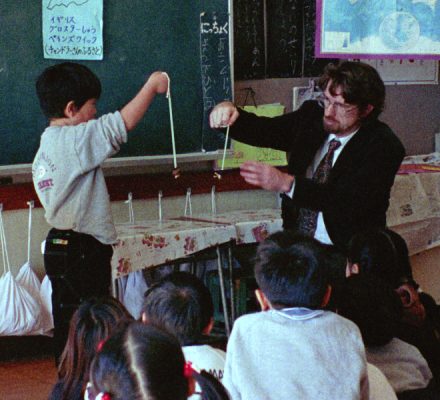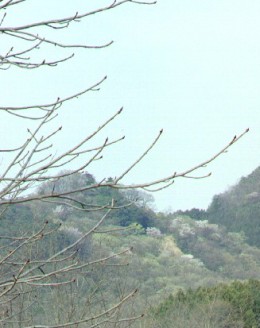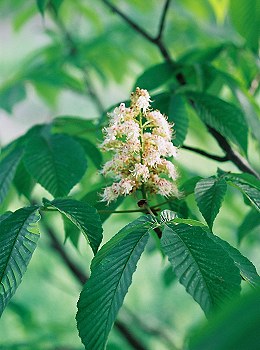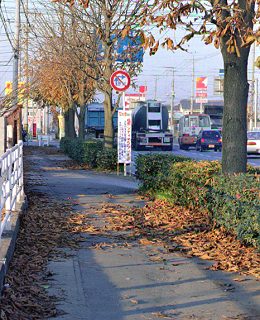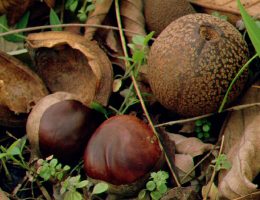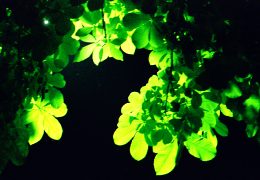Tochi-no-kiAesculus turbinata Blume - Japanese horse chestnut
Me, showing local kids how to play conkers
|
|
 Sticky buds (January)
|
Since coming to live in Tochigi-ken, I've always thought the general awareness of our "prefectural tree" oddly low. I grew up in Gloucestershire, in the south-west of England, where the European horse chestnut (Aesculus hippocastanum L.) is very common, and not only did we play "conkers", but also gathered the "sticky buds" and watched them open into flowers in our primary school classroom.
Here, though, the game of conkers is unheard of, and although there are plenty of horse chestnut avenues, the flowers seem somehow less spectacular than those I remember. Ah, well, the first thing I learnt from a web search before writing this page is that the Japanese horse chestnut is a distinct species, Aesculus turbinata Blume. The buds are very similar: throughout the winter they are coated in a rich brown sticky goo, which gives them their common name, and also traps insects. The twigs are characteristically thick and somehow angular, giving the winter tree a gawky appearance. I think you would have to be an expert to tell the Japanese and European varieties apart in the winter.
Eventually the buds explode into the huge trademark leaf clusters, and candlestick blossoms. Perhaps the trees here are not really given a chance to display at their best. Imagining a horse chestnut avenue in England immediately conjures up a broad approach to a stately home, the trees allowed to grow to their full height and splendour. But in Sano at least, they are brutally forced into the margins of a four-lane road, and pruned hard. No wonder no-one notices.
Towards the end of the summer, the fruit pods form. This is where I noticed the difference from the English version: instead of the prickles, the pods are covered only in a blistery pattern, and are generally smaller, with typically only a single nut, or "conker", inside.
|
|
Children here seem blissfully unaware of their possibilities, so when I was asked to go and talk about England to Aki's class (eight-year-olds) early in 2000 and show them a game from my childhood, I took the obvious opportunity. We asked the kids to collect conkers (tochi-no-mi), and got an amazing collection, mostly of acorns of one sort or another. Another slight obstacle to progress was that unfortunately I was never particularly successful at this sort of activity. Nonetheless, we drilled up the necessary forty or so conkers, threaded them with string, and miraculously without breaking any bones or windows, pairs of the kids tried to smash each other's conker. It's hard to encourage quite the necessary degree of violence in an activity they have never seen before, but at least one conker did get totally smashed and defeated.
|
|
The leaves turn a yellowy-brown, and fall. The trees don't seem to synchronise well, so again, the display on the side of the road is slightly disappointing. In case you think that one tree's dead leaves are the same as any other tree's dead leaves, by the way, in contrast to the soggy mess yielded by some species, horse chestnut, and the Japanese variety is no exception, has leaves which curl up when dead, and are generally unusually crispy. I recall going on a winter twilight walk in England a few years back. It was just too dark to see, but I suddenly realised that I could tell exactly what sort of tree I was walking under, from the distinctive light rustle of the horse chestnut leaves underfoot.
 "Prefectural tree"?
"Prefectural tree"?
Sano is in Tochigi-ken, (Tochigi Prefecture) named after Tochigi, the next city to the East. This is written with the same characters, so is presumably simply a variant (old?) way of saying "horse-chestnut tree". Now in the Japanese way of doing things, every prefecture has to have its set of emblems - a bird, a flower, a song, and so on, and naturally this is our prefectural tree. (They are quite keen on this sort of thing in America too, it seems, and the Ohio Buckeye (Aesculus glabra) is rather unsurprisingly the state tree of Ohio.
Read some more about the name in Japanese in my jeKai entry.
|
|
 Family
Family
So what are the members of the Aesculus family? There are quite a few, but these are the principals:
- Aesculus turbinata Blume - the Japanese horse chestnut, native to all of mainland Japan the books say, though it certainly seems commoner as a planted tree. Supposed to grow up to 15 or 20 metres tall.
- Aesculus hippocastanum L. - the European horse chestnut, native to southern Europe. Very common as a parkland tree in England at least. Somewhat larger than the Japanese horse chestnut, and can reach 25 metres.
- Aesculus glabra - the Ohio buckeye. Most of the American species are generally known as "buckeye", supposedly because the pale scar on the seed looks like a buck's eye.
- Aesculus pavia - Red buckeye, or firecracker plant. Another American species, but also mentioned as a cultivated variety in my British tree and shrub book. There are any number of other "buckeye" varieties.
(Incidentally, it seems that the last bit of the full Latin name is the person who assigned the name, and we're supposed to know that "L." always stands for Linnaeus.)
|
|
 Can you eat them?
Can you eat them?
I was brought up to believe that you can't eat horse chestnuts. A web search reveals a bewildering conflict between sites warning of the dangers of poisoning, and others advocating herbal use. To be fair, everyone seems to agree that they are poisonous in the raw state, and some sort of lengthy processing is required to eliminate toxins. Japanese sources suggest that starch can be obtained from them, and there are also reports that they have been used as a staple food during hard times. (I wouldn't recommend trying - but I found the site listed below advertising rice-cakes flavoured with them.)
|
Photographic note
The picture at the top was taken by teacher, and while it does an excellent job of capturing the moment, there were technical problems with the string. Here's my question to PhotoForum: ... Problem is that conkers involves a piece of string at about 10 degrees to the vertical, which in an appropriate size picture ends up about 1 pixel thick. The result is horrific jaggies. I'm using the standard (resampling) resize with Paint Shop Pro. Has anyone any brilliant ideas on effective ways of tidying this up?
In photoshop I would just take the straight line tool and set it to 2 pixels and draw a white line over the one that is already there. How gross! Why didn't I think of that? You can see the problem in the enlargement on the right - once I'd painted over it with rather thicker string, the "pulsating" effect went away. (Just for the record, Norman Havens also created this joky version.) |
![]()
Links
In EnglishA web search on "aesculus" will turn up a huge number of useful sites. Just a tiny sample... AmericaUniversity of Minnesota Extension Service - a comparison of horse chestnuts, (A hippocastanum), Ohio Buckeye (A. glabra) and the American chestnut (Castanea dentata). Poisonous Plants of North Carolina says Aesculus pavia (Red buckeye, firecracker plant) is "HIGHLY TOXIC, MAY BE FATAL IF EATEN!" Meanwhile, Alternative Nature Online Herbal Cherokee herbology lists medicinal uses for it. BritainConkers and the HorseChestnut Tree from The Royal Forestry Society World Conker Championships are now sponsored by Ben and Jerry's ice cream. |
In JapaneseShiramine tochimochi Producers of tochimochi, or horse chestnut flavoured rice-cakes. Follow the links for: description of the fruits - how the cakes are eaten - the lengthy process of making them - and products for saleIn SpanishChilena gana concurso de Karaoke en Tochigi
|
